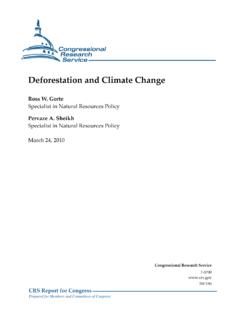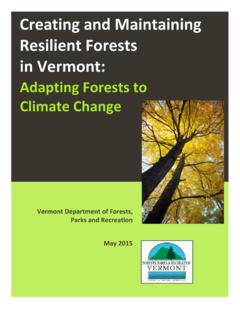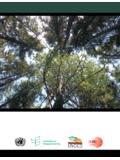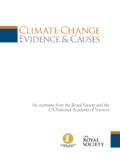Transcription of Adapting Urban Forests to Climate Change in the Chicago ...
1 34 | Arborist News | TThe Urban forest is a key component in building commu-nity resilience to a changing Climate . Many municipal Climate action plans include increasing tree canopy as part of their overall adaptation or mitigation strategies, as they can help reduce the Urban heat-island effect, control storm-water, and store carbon. Despite this, few Urban areas have examined the vulnerability of their trees to current and future Climate conditions or developed specific adaptation plans to ensure that their Urban Forests continue to provide benefits into the future. The Northern Institute of Applied Climate Science (NIACS), a multi-institutional partnership supported by the forest Service that focuses on incorporating Climate - Change considerations into forest management, teamed up with partners in the Chicago , Illinois, , region to develop a framework for Climate - Change adaptation in Urban for-ests (Brandt et al.)
2 2016a). NIACS and its partners at The Morton Arboretum, The Field Museum, the Chicago Botanic Garden, and the Chicago region Trees Initiative used the Chicago region as a test case for Urban forest vul-nerability assessments and adaptation with the hopes that lessons learned can be applied to other Urban areas (Brandt et al. 2016b). Vulnerability of the Region s TreesWhich tree species are the most at risk to current and projected Climate changes in the Chicago region? To find Adapting Urban Forests to Climate Change in the Chicago Region By Leslie A. Brandt, Abigail Derby Lewis, Lydia Scott,Robert T. Fahey, Lindsay Darling, and Christopher W. Swanstonout, we assessed the vulnerability of the trees most com-monly found in the Chicago region (Brandt et al.
3 2017) based on a recent sample inventory (Nowak et al. 2013). We sought to understand how vulnerable different trees were by first examining how changes in temperature and pre-cipitation may affect habitat suitability. For native trees, we relied on modeled projections of habitat suitability developed by the forest Service Landscape Change research Group (Landscape Change research Group 2014). These projections incorporate changes in temperature, precipi-tation, and factors such as soil type in natural habitats. For non-native trees and cultivars, we compared known heat and hardiness zone ranges of each species to current and projected heat and hardiness zone ranges for the region (Table 1).
4 For example, a tree species with a maximum Heat Zone tolerance of 7 would be considered to be neg-atively impacted by Climate Change because the area may reach Heat Zone 8 within a tree s lifespan (Figure 1).Habitat suitability models and changes in Heat and Hardiness Zones only tell part of the story, however. Warmer temperatures and changes in precipitation may make conditions more favorable for some pests and diseases, and more extreme storms increase risk for species intoler-ant of wind, ice, or flooding. In addition, some species may be more or less adaptable to a range of site conditions found in Urban environments. We addressed these factors by developing adaptability scores for each species based Table 1.
5 Current and projected USDA hardiness Zones and AhS heat Zones for the Chicago region under low and high greenhouse gas emissions scenarios (Brandt et al. 2017). Low emissions High emissions 1980 2009 2010 2039 2040 2069 2070 2099 1980 2009 2010 2039 2040 2069 2070 2099 Hardiness Zone 5b 6a 5b 6a 6a 6b 6a 6b 5b 6a 6a 6b 6b 7a 7a 7bHeat Zone 4 5 5 6 5 6 5 6 4 5 6 7 7 8 8 DeCeMBer 2017 | 35 Figure 1. Schematic for determining habitat suitability for a species using current and projected USDA hardiness Zones and AhS heat Zones.
6 This example species may be negatively affected because the species is only tolerant to heat Zone 7, but the area may reach heat Zone 8 by the end of the their tolerance of disturbances and capacity to adapt to a variety of environments (Matthews et al. 2011). Adaptability scores were then combined with modeled changes in habitat suitability to give an overall rating of vulnerability. Species with low vulnerability are adapted to current and future climates and have a variety of traits that make them tolerant of disturbances and a wide range of site conditions. Species with high vulnerability are those that are not adapted to current or future conditions, are less tolerant of disturbances, or have very specific site require-ments.
7 These species may have reduced health or produc-tivity, and may eventually experience more mortality than species that are less vulnerable. Our assessment revealed that the majority of trees in the region had low or low-moderate vulnerability (Figure 2). However, many of those trees were invasive species, such as european buckthorn (Rhamnus cathartica) or Amur honeysuckle (Lonicera maackii) (Table 2). Many of the region s native species were vulnerable, especially those at the southern end of their range, such as balsam fir (Abies balsamea), paper birch (Betula papyrifera), white pine (Pinus strobus), and white spruce (Picea glauca). Community-Level VulnerabilityGetting a sense of what s vulnerable at a regional scale is helpful, but how does this translate to management of specific areas?
8 We answered this question by developing a process for municipalities, park districts, and forest preserve districts to assess their own vulnerability to Climate Change based on the composition of their Urban forest , physical factors, and human dimensions, such as organizational capacity, funding, and community support. Ten case studies were developed in the Chicago region using this approach. We found that most communities expected a similar degree of negative impacts on their Urban Forests , but had a greater variation in their perceived adap-tive capacity (Figure 3). In general, communities that had Urban Forests with high species, genetic, and age class diversity and had sufficient organizational, technical, social, and economic resources were less vulnerable to Climate - Change impacts.
9 Adapting to ChangeOnce we understand how vulnerable our Urban Forests are to Climate Change , how can we adapt our management? Adaptation actions are designed to specifically address Climate - Change impacts and vulnerabilities in order to meet Climate -informed goals or objectives (Figure 4). Adaptation actions can include resisting Change , such as watering during drought periods or installing gray or green infrastructure to control flooding. They can also include building resilience through enhanced age, species, and genetic diversity. Finally, there may be some cases where managers may want to facilitate transitions through activities, such as incorporating new species that are not currently found in their area or con-verting from one ecosystem type to another.
10 Figure 2. Percent of trees in the Chicago region in each of five vulnerability categories (Brandt et al. 2017).u36 | Arborist News | Tools are available to assist with the process of devel-oping adaptation strategies for a specific site. NIACS designed the Adaptation Workbook as a flexible, logical process to consider Climate - Change information and to design customized management actions that can help managers achieve their objectives (Swanston et al. 2016; Figure 5). The workbook integrates a menu of adaptation strategies specific to Urban Forests that was developed by NIACS and its partners in the Chicago region and is applicable to Urban Forests in most temperate areas.









